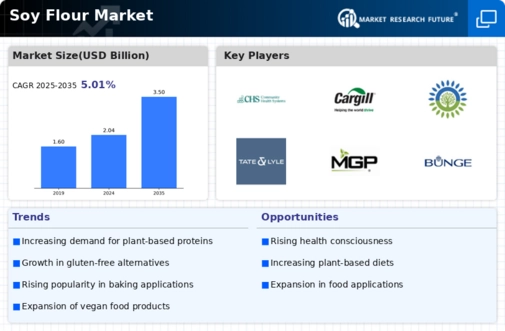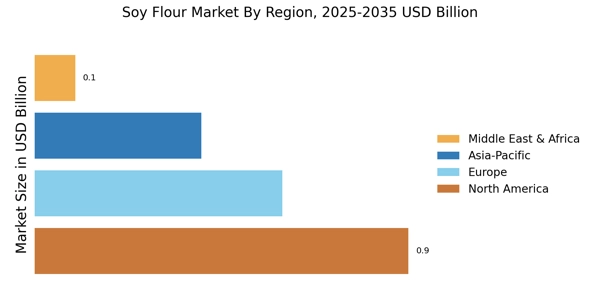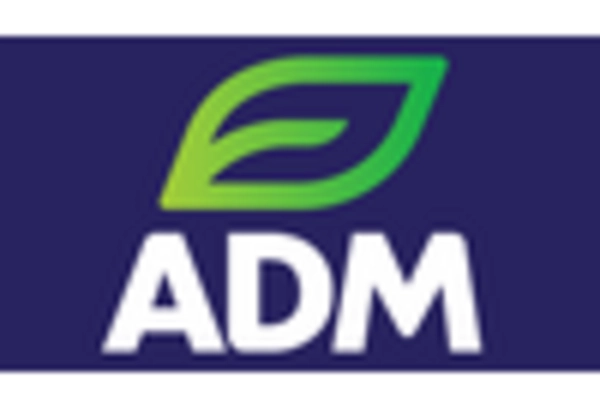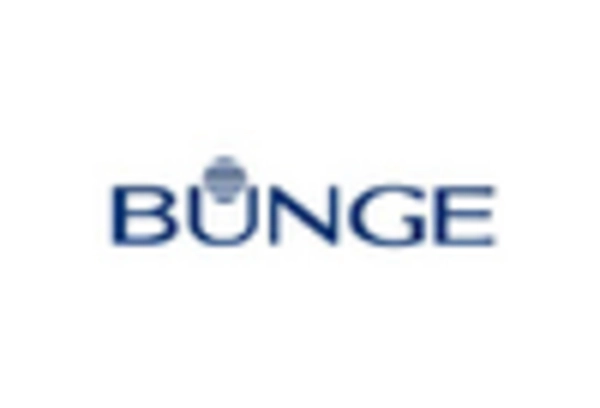Rising Health Consciousness
The Soy Flour Market appears to be experiencing a surge in demand driven by increasing health consciousness among consumers. As individuals become more aware of the nutritional benefits associated with soy flour, such as its high protein content and low glycemic index, the market is likely to expand. Reports indicate that soy flour is often utilized in various health-oriented products, including protein bars and meal replacements. This trend suggests that manufacturers are increasingly incorporating soy flour into their formulations to cater to health-conscious consumers. Furthermore, the growing prevalence of lifestyle-related diseases has prompted consumers to seek healthier alternatives, thereby enhancing the appeal of soy flour in the market. As a result, the Soy Flour Market is poised for growth as it aligns with the evolving dietary preferences of consumers.
Increased Adoption in Food Processing
The Soy Flour Market is witnessing increased adoption in food processing sectors, which may significantly influence its growth trajectory. Soy flour is often utilized as a functional ingredient in various food products, including baked goods, snacks, and meat alternatives. The versatility of soy flour allows it to enhance texture, improve moisture retention, and provide nutritional benefits. Data suggests that the food processing industry is increasingly recognizing the advantages of incorporating soy flour into formulations, leading to a rise in its usage. Additionally, the trend towards clean label products has prompted manufacturers to seek natural ingredients, further driving the demand for soy flour. This shift indicates that the Soy Flour Market is likely to benefit from the evolving landscape of food processing, as companies strive to meet consumer expectations for healthier and more sustainable food options.
Growing Vegan and Vegetarian Population
The Soy Flour Market is likely to benefit from the growing population of vegans and vegetarians, which appears to be a significant driver of market growth. As more individuals adopt plant-based diets, the demand for alternative protein sources, such as soy flour, is expected to rise. Reports indicate that soy flour is often used in various meat substitutes and dairy alternatives, making it a crucial ingredient for those seeking to reduce animal product consumption. This trend suggests that the Soy Flour Market is well-positioned to cater to the needs of this expanding demographic. Furthermore, the increasing awareness of the environmental impact of animal agriculture may further encourage consumers to explore plant-based options, thereby enhancing the market potential for soy flour. As a result, the Soy Flour Market is likely to experience sustained growth in response to these dietary shifts.
Technological Advancements in Production
The Soy Flour Market is experiencing a transformation due to technological advancements in production processes. Innovations in milling techniques and processing technologies have improved the quality and functionality of soy flour, making it more appealing to manufacturers and consumers alike. Enhanced production methods may lead to better nutrient retention and improved flavor profiles, which could positively impact market demand. Additionally, advancements in food technology are enabling the development of new applications for soy flour, such as in gluten-free products and specialty foods. This evolution suggests that the Soy Flour Market is adapting to meet the changing needs of consumers and food manufacturers. As technology continues to advance, the potential for new product development and market expansion appears promising, positioning the Soy Flour Market for future growth.
Sustainability and Eco-Friendly Practices
The Soy Flour Market is increasingly influenced by sustainability and eco-friendly practices, which seem to resonate with contemporary consumer values. As awareness of environmental issues grows, consumers are more inclined to support products that align with sustainable practices. Soy flour, being a plant-based ingredient, is often perceived as a more environmentally friendly alternative to traditional flour sources. This perception may drive demand as consumers seek to reduce their carbon footprint. Furthermore, manufacturers are likely to adopt sustainable sourcing and production methods to appeal to eco-conscious consumers. Reports indicate that the integration of sustainability into product offerings is becoming a key differentiator in the market. Consequently, the Soy Flour Market is expected to thrive as it aligns with the increasing consumer preference for sustainable and ethically produced food ingredients.


















Leave a Comment